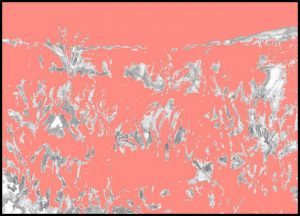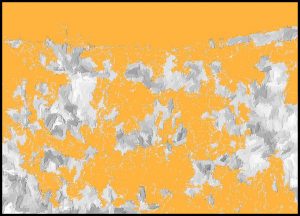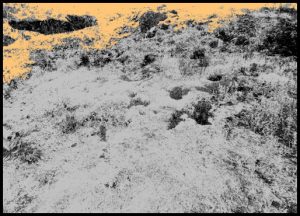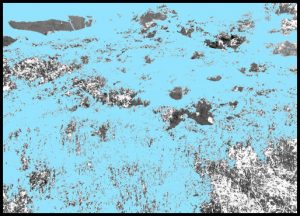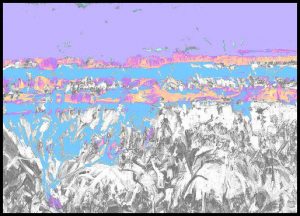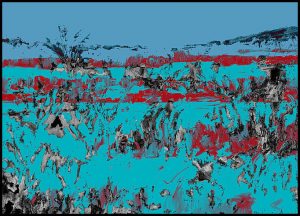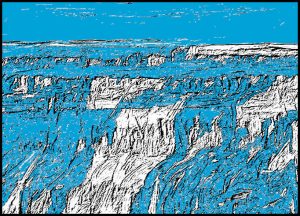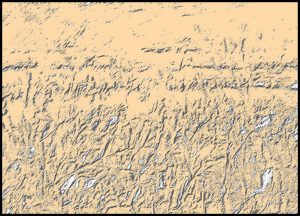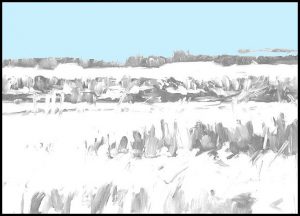Skomer Grass I
Skomer Island National Nature Reserve is an offshore scrap of mentally energising volcanic rocks set in the wild seas pounding the south west corner of Wales. It is a sombre place clothed in greens, grays and browns. Occasionally it is flushed with amazing sunsets and deep blue horizons of sea and sky, This small piece of land can be thought of as a secular place having no historic or archaeological connection with the Celtic saints who evangelised the mainland from other Welsh islands, yet it was settled at least a millennium before the birth of Christ. Most visitors today come to experience the wildness of the sea birds that nest there in prodigious numbers. Nevertheless to cross over a turbulent Jack Sound isolating Skomer from the mainland, is to make sacred voyages of the mind, which are experiential journeys deep into the Spirit of places with a strong past. These are responses you can get, if you are lucky, when visiting ancient places elsewhere. Musing on the island’s farmers who, tuned to the tides and winds, had to regularly row across the Sound in times past, can generate a state of mindfulness. Pondering on the relevance of shared experience, and its ability to potentially transcend barriers of space and mortality, gives Skomer a temple quality not of this time and place.
One of the first people to express this state of mind in art was the American 19th century poet Walt Whitman in his work “Crossing Brooklyn Ferry. Whitman was an outstanding American who felt at one with nature and in most of his poems he tried to encompass the connection between nature and humanity. Reminding himself that others have seen, and fifty years from now will still be seeing, the islands of New York City, he realizes that others have also shared his range of emotional and spiritual experience. This makes him significant as an individual but also part of a larger whole.
Skomer Grass II
Others will enter the gates of the ferry and cross from shore to shore,
Others will watch the run of the flood-tide,
Others will see the shipping of Manhattan north and west, and the heights of Brooklyn to the south and east,
Others will see the islands large and small;
Fifty years hence, others will see them as they cross, the sun half an hour high,
A hundred years hence, or ever so many hundred years hence, others will see them,
Will enjoy the sunset, the pouring-in of the flood-tide, the falling-back to the sea of the ebb-tide.
This poem seeks to determine the relationship of human beings to one another across time and space. Whitman wonders what he means, not as a poet but as another anonymous individual, to the crowds of strangers he sees every day. He assumes that they see the same things he does, and that they react in the same way, and that this brings them together in a very real sense. This kind of thinking is amplified through contact with wildness; a wildness not of the African savanna but of a neglected lawn dressed in its bare patches and invading weeds.
Skomer Grass III
These transformational life-changing experiences take place on all islands where the veils between humanity and nature are thinner and where miraculous reorientations of urban attitudes and behaviours regularly happen. On Skomer itself such a reorientation comes about because the surface is dominated by the socialising of wild creatures with untamed grassland, littered with the desiccated corpses of seabirds and rabbits. The resemblances of the grasses to oats, rye, barley and wheat, the grains that have nourished humankind for millennia, connects the visitor dynamically to the first prehistoric farmers who have left evidence of their small community as stone walls networked to a family of round houses. Nestling in the wild grassland and dense bracken of a sub maritime habitat, these archaeological remains spark feelings of humanity’s oneness with nature because they are now a significant part of unmanaged ecosystems.
Today we would call Walt Whitman an ecological poet who was trying to express in words the dynamic biochemical cultural relationships we have with the material world of the soil and stars. He often refers to humanity being part of the circle of life, believing in the idea that in terms of our chemical makeup humans never really die. “I celebrate myself, and sing myself,” is one poem where he relates himself and humankind to nature. In this poem, he offers the idea that we are part of the chemistry of nature, which is flowing through the life forms around us. One line reads, “My tongue, every atom of my blood, form’d from this soil, this air…”
Skomer Grass IV
Whitman makes something mundane, like grass, seem extraordinary and unusual. He takes this seemingly inconsequential object and imbues it with meaning, making it a symbol for the human condition. By doing this, he challenges his readers to take a moment to ponder the world around us, just like children learning about nature for the first time.
In “A child said What is the grass? ” he responds with another question “What has become of people who have died”. His answer is, they are alive and well somewhere, the smallest sprout incorporating some of the chemistry of human breath says there is really no death. In other words we have a temporary existence as part of a chemical sequence of beings, maintained through evolution as a series of temporary biochemical steady states. Like a candle flame that is burning steadily as wax enters and leaves as carbon dioxide and water, there is a steady coming and going of the elements of the bodies of all living things. In life and death elements passing through humans day by day and year on year, are quickly incorporated into other life forms. Whitman develops the concept that we are part of a chemical circle of life that goes on, even after death. For instance, in “The spotted hawk swoops by. ” he says that when we die, we become part of the non-living world from whence we came. If he is missed after death, we will find him under our shoes!. To finish his poem he says, “Failing to fetch me at first keep encouraged, Missing me one place search another, I stop somewhere waiting for you. ”
Skomer Grass V
In “A Noiseless Patient Spider,” Whitman compares humans to a spider in nature. He says as spiders throw out their web, so do we also try to throw out our “web” to make connections with the universe. He says that humankind is, “Ceaselessly musing, venturing, throwing, seeking the spheres to connect them…” His poems are his attempt to encourage us to maintain this effort of creative inquiry into our origins and our fate, which makes us human
A child said, What is the grass?
A child said, What is the grass? fetching it to me with full
hands;
How could I answer the child?. . . .I do not know what it
is any more than he.
I guess it must be the flag of my disposition, out of hopeful
green stuff woven.
Or I guess it is the handkerchief of the Lord,
A scented gift and remembrancer designedly dropped,
Bearing the owner’s name someway in the corners, that we
may see and remark, and say Whose?
Or I guess the grass is itself a child. . . .the produced babe
of the vegetation.
Or I guess it is a uniform hieroglyphic,
And it means, Sprouting alike in broad zones and narrow
zones,
Growing among black folks as among white,
Kanuck, Tuckahoe, Congressman, Cuff, I give them the
same, I receive them the same.
And now it seems to me the beautiful uncut hair of graves.
Tenderly will I use you curling grass,
It may be you transpire from the breasts of young men,
It may be if I had known them I would have loved them;
It may be you are from old people and from women, and
from offspring taken soon out of their mother’s laps,
And here you are the mother’s laps.
This grass is very dark to be from the white heads of old
mothers,
Darker than the colorless beards of old men,
Dark to come from under the faint red roofs of mouths.
O I perceive after all so many uttering tongues!
And I perceive they do not come from the roofs of mouths
for nothing.
I wish I could translate the hints about the dead young men
and women,
And the hints about old men and mothers, and the offspring
taken soon out of their laps.
What do you think has become of the young and old men?
What do you think has become of the women and
children?
They are alive and well somewhere;
The smallest sprouts show there is really no death,
And if ever there was it led forward life, and does not wait
at the end to arrest it,
And ceased the moment life appeared.
All goes onward and outward. . . .and nothing collapses,
And to die is different from what any one supposed, and
luckier.
The poem begins with a child asking a simple question: “What is the grass?” The speaker contemplates that it is hard for him to answer, since he hardly knows any better than the child does. He goes on to ponder possible responses to the query. First, he calls the grass “the flag of my disposition,” woven from his own hopes. Then he calls it the “handkerchief the Lord,” intended to remind us of His power. Next he muses that the grass is also child of the vegetation. He then calls it a “uniform hieroglyphic,” pointing out that it grows around all people regardless of race or identity. Then, he writes that the grass seems like the “beautiful uncut hair of graves.”
Skomer Grass VI
He pronounces that he will “tenderly use” the grass, considering the possibilities of its origin. It may have come from the breasts of young men whom he might have loved. It may have grown out of the remains of old people, women, or children who died too young. He remarks that the grass is very dark to have come from the white hair of old mothers or the colourless beards of old men. The speaker wishes he could translate the hints grass gives about the individuals who lie beneath it. He asks for the reader’s opinion on what happened to these men, women, and children but then answers his own question. He decides that they are alive and well somewhere; the sprouts of the grass indicate that death is not permanent because it leads to new life. He then concludes that death is different and much “luckier” in passing its substance on to other life, than he had previously believed.
Though the majority of the poem is made up of the possible ways to define the grass, the third-to-last stanza contains the speaker’s own question. What has become of the dead buried in the ground? In the following two stanzas, he answers this question himself.
Skomer Grass VII
This poem contains traces of the global ideals that resonate throughout Whitman’s poetry, notably in the stanza in which he suggests that the grass is a “uniform hieroglyph” that can unite people regardless of race, occupation, or social status. He reminds his reader that nature connects all human beings and the divisions between us are superficial. The line,
” I give them the same, I receive them the same” represents Whitman’s recommendation that human beings take a cue from the grass and treat one another equally.
Skomer Grass VIII
Death is a major theme in this poem, which takes the child’s innocent query into a much darker place. Whitman incorporates all facets of the human condition into his poetry because, in his opinion, death is a major part of life and nature. Whitman showcases his belief that death marks a beginning rather than an ending. The grass grows, dies, and is reborn in a constant cycle, and Whitman believes that human life is the same. This is the contemporary message of Skomer to its visitors. Every year the visual impact of its grassy ecosystems is different as new patches of colour and form appear, only to disappear in following years. A regular visitor will remember seeing swathes of dead grass, which were followed by a revitalising greening up succession involving a few common species that bring the island full circle back to what it looked like before being disturbed by changes in the weather or mortality of rabbits. Other changes in vegetation seem to be progressive, tracking climate change as an indication of a mainland economy organised to gratify our immediate wants, which grow year by year, paying no attention to the cycle of life which sets the ecological limits within which we all must live.
Skomer Grass IX
Skomer Grass X
Skomer Grass XI
